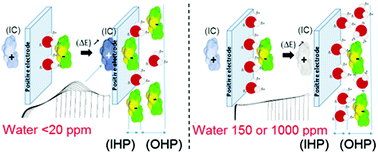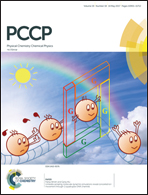Effect of low water content in protic ionic liquid on ions electrosorption in porous carbon: application to electrochemical capacitors
Abstract
The effect of low water content (<20, 150, 1000, 10 000 ppm) in triethylammonium bis[(trifluoromethyl)sulfonyl]imide – [(C2H5)3N+H][TFSI−] – protic ionic liquid (PIL) on the performance of activated carbon (AC) electrodes as well as AC/AC electrochemical capacitors (ECs) is reported. Under negative polarization, hydrogen electrosorption onto carbon is enhanced along with the increase of water content in PIL, whereas the resulting desorption peaks are shifted to lower potential values, evidencing lower sorption energy when hydrogen is stored from moisture containing PIL. Cyclic voltammetry (CV) investigations on PIL-based ECs demonstrated that the evolution of the Stern layer nanostructure at positive and negative potentials is asymmetrical. The results revealed comparable electrochemical performance for PIL containing 150 and 1000 ppm of H2O, due to similar operation of the positive electrode, where [TFSI−] anions are adsorbed in the outer Helmholtz plane, and the negative one, where hydrogen is stored through the reduction of the intermediate hydronium cation. By contrast, a cell with “dry” PIL (<20 ppm of water) displayed a distinctive operation due to hydrogen electrosorption directly through reduction of the protonated cation, and selective adsorption of [TFSI−] anions, which occurs thanks to the high polarizability and image force (IF) created by their induced charge. Galvanostatic cycling with potential limitation (GCPL) showed comparable capacitance values whatever the water content in PILs up to 1000 ppm, yet electrochemical impedance spectroscopy (EIS) revealed higher capacitance as well as better retention at higher frequencies with the PIL containing 150 ppm of water. Hence, 150 ppm is reasoned to be an optimal value for diffusion and adsorption of ions. The nature of current collectors (aluminum or stainless steel) has a determining role in their polarization behavior, and consequently the potential range of electrodes as well as ion diffusion into the activated carbon porosity, influencing the observed capacitance values (CEIS/2.0V: 170 vs. 128 F g−1, for Al and SSt, respectively).



 Please wait while we load your content...
Please wait while we load your content...